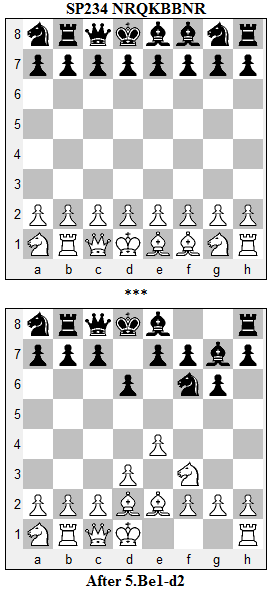My play wasn't as good as the result might indicate. Two of my strongest opponents defaulted in positions that were entirely unclear and which could have gone either way. I would have been lucky to win both games and a loss in either would have meant certain elimination.
My only loss was against the eventual winner of the event, the same player who beat me in the 2009 event. I covered a position from that earlier game in another post, Symmetry Misjudged. He coasted to victory in the 2010 event using a classic tournament strategy, winning all of his games as White, while drawing his last four games as Black.
The position in the top diagram shows the start position, SP234 NRQKBBNR. Its most striking feature is probably the traditional formation of the BNR on the Kingside. I decided that castling O-O was the most likely plan for both players and expected my opponent to open with 1.d4. I was surprised when he played instead 1.d3, which might well have been the first time that a strong player started with a single step of a Pawn as the first move against me. I answered 1...Nf6, and we were off. The next few moves were 2.Nf3 g6 3.e4 d6 4.Be2 Bg7 5.Bd2, reaching the position in the bottom diagram.

Both players have used their first moves to pursue rapid development and White is already able to castle O-O. I wanted to continue 5...Bc6, but was concerned that the Bishop was somehow exposed on that square. I decided to play 5...c5, making a shelter for the Bishop, but wasn't certain if the loss of time would work against me. As I expected, White played 6.O-O, and I continued 6...Bc6.
Now tactics unfolded quickly with 7.e5 Nd7 8.exd6 exd6 9.Bg5+ Nf6 10.Re1, when Black has to react with 10...O-O, or lose the option to castle. White continued to play aggressively, hitting me with a combination a few moves later where I overlooked the key move. I eventually lost a Pawn, then another Pawn, and struggled on to the 47th move, when I resigned.
After the game, I couldn't find anything wrong with my play, except for the uncertain 5...c5. Was that the losing move? It doesn't look like one, but in chess960 you're never really certain how you stand in the opening.

1 comment:
Eh Mark
Nice game. Forgive me if there are errors in this post, but it's getting harder to preview my reply with Google's extra security checks.
Probably coincidental but your opponent played out the first four moves as per the favored CCRL engine openings for SP234 as of a couple of months ago. You were the first to deviate on move four. What is remarkable that the CCRL engine playing black decided on a similar idea to yourself (to delay the center and fianchetto a bishop early).
Looks to me like you are spot on with c7-c5 being the culprit. This is because the d6 square is too weak resulting in a backward pawn early (unlike the traditional start). My engine "Critter" thinks that the better plan is not to weaken d6 any further and play out ...Be8-d7 immediately.
The other fascinating point is that your idea of ...Bc6 is a very subtle example of my gross blog on that idea over here:
http://chess960jungle.blogspot.com.au/2012/01/chess960-bf3.html
I haven't yet found an example where the move Bc6 or it's equivalents works, in the case when there is an opposing knight, as there is in SP234 with the knight on a1.
Whatever, I'm no expert!
Enjoy 960.
Cheers
Harry
Post a Comment